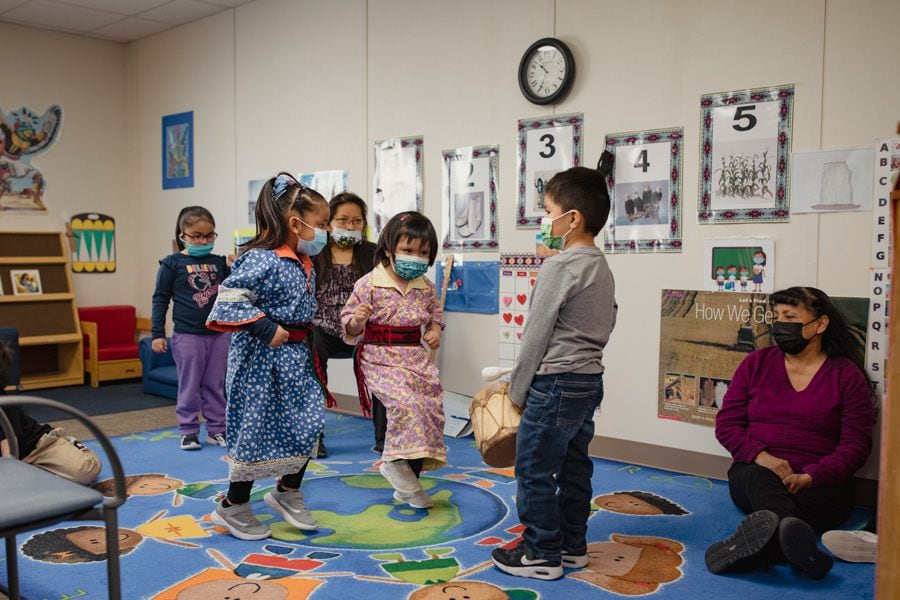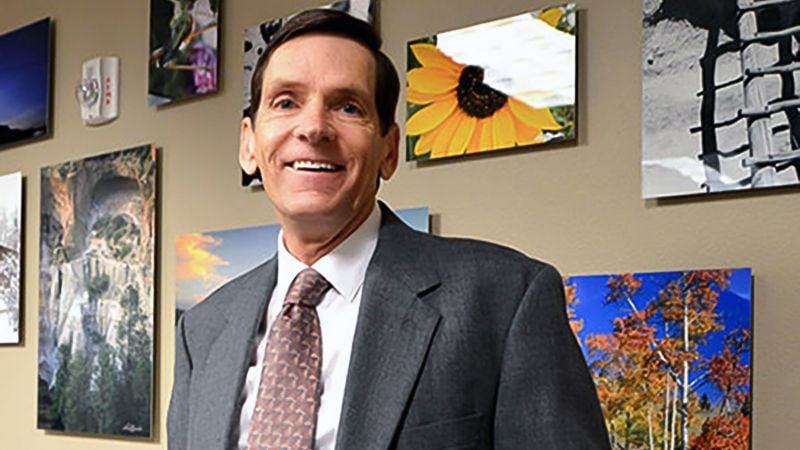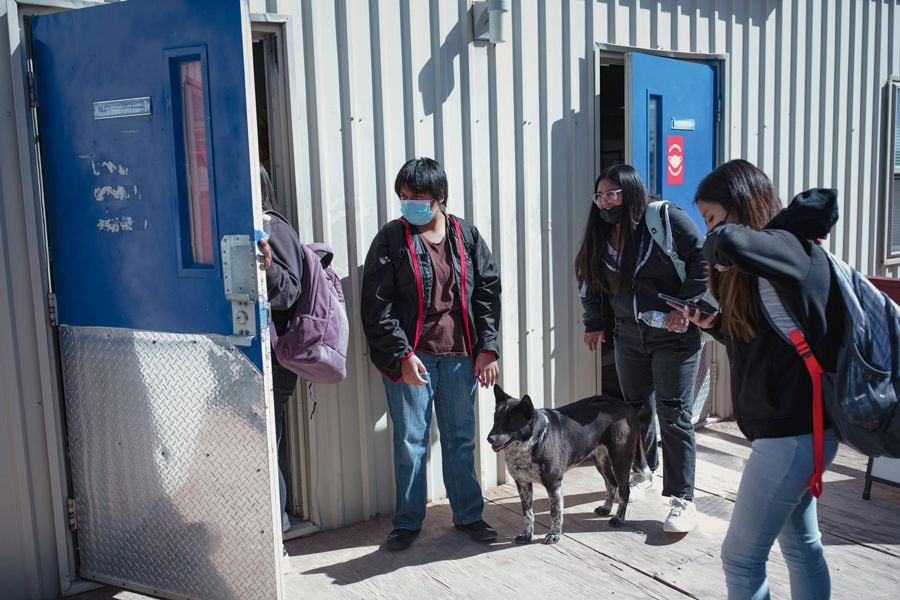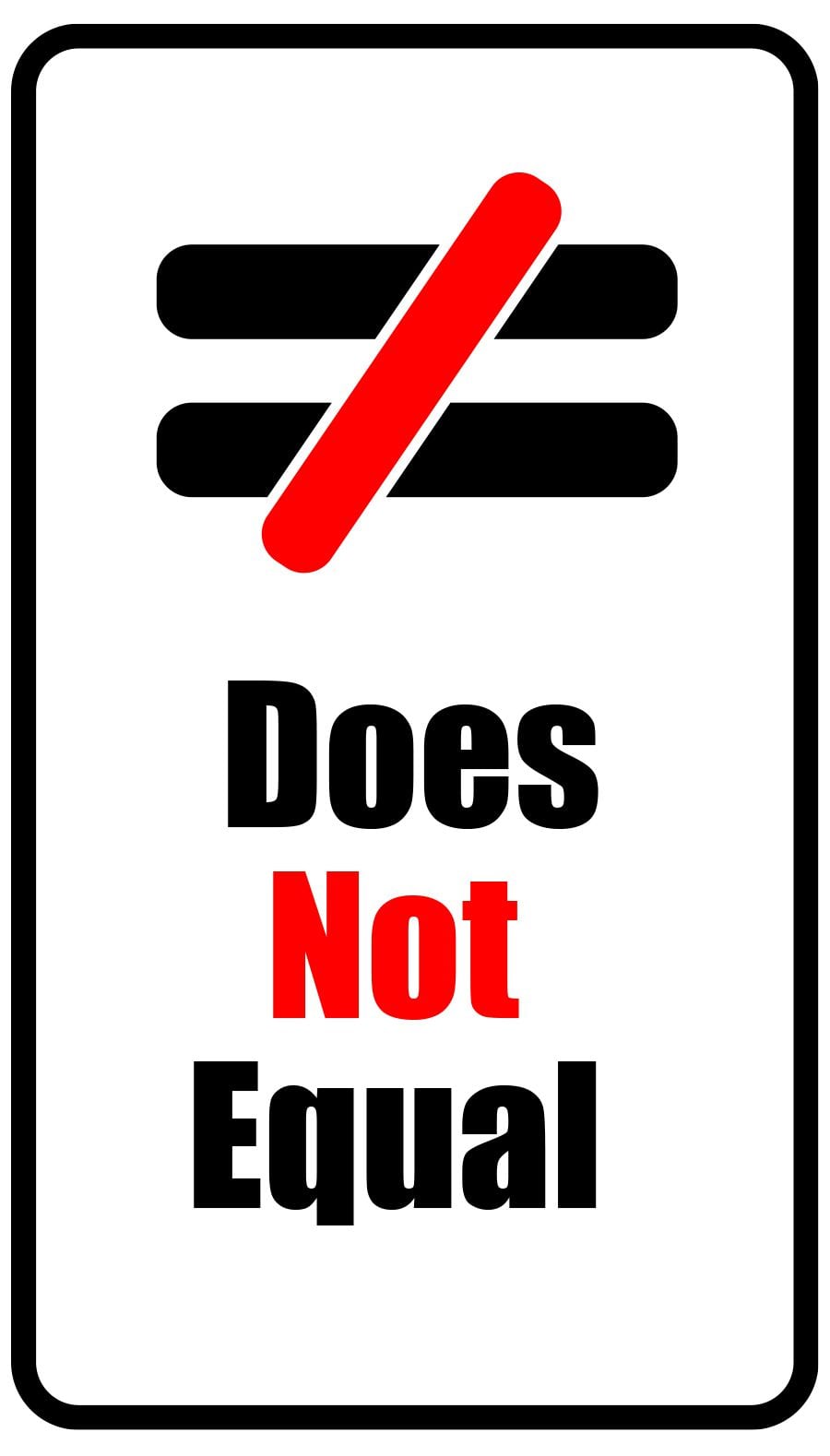JEMEZ PUEBLO—A game of duck, duck, goose; colorful, laminated pictures; songs, dances and a zero-English policy—this is what it looks like to protect an unwritten language, distinct from its neighboring tongues, only spoken by a few thousand people in the world.
On a recent morning at the Walatowa Head Start Language Immersion Program, the youngest speakers of Towa sit on a carpet promoting global friendship, fidgeting and looking around at the heavily postered classroom. Teacher Jacqueline Magdalena asks one of the younger-looking boys, in Towa, which clan his family claims.
He’s nervous and shies away from different images, representing family clans, tacked to the wall.
When the question finally clicks, the boy points to the image of an eagle and slips into a practiced series of movements that Magdalena later explains is known as the eagle dance.
“He’s got moves,” Magdalena says later, laughing as she lifts the ban on English for SFR after the children have gone home.
While the room’s soothing background music and yellow, red and blue construction-paper birds hanging from the ceiling suggest a certain lightness, there’s serious work being done here.
“We continue our fight because we don’t want to lose our language,” says Lana Garcia, the early childhood program manager at Walatowa.
The fight for linguistic and cultural preservation predates statehood, given the assimilatory nature of Western education taught in New Mexico’s public schools. The struggle has been ongoing and, despite a massive victory through acknowledgment in a seminal court case, it continues through to today, an SFR analysis of fairness in the state’s education system finds.
In 2014 families, teachers and schools from across New Mexico banded together to bring attention to the dismal state of public education, suing the state for violating their students’ constitutional rights to a sufficient and adequate education.
A court order and a pandemic later, the state’s education landscape for Indigenous students, English-language learners and others who have been systemically held back for generations looks different than it did eight years ago, but not entirely for the better.
Initiatives designed to increase equity and billions of federal and state dollars have flowed into schools, much of it directed at the “at-risk” students identified by a 2018 judge’s ruling in the Martinez and Yazzie v. State of New Mexico lawsuit.
In the courtroom, at least, state officials including the two most recent governors appear to believe they’ve done enough, spending millions more in legal costs to end the case. Gov. Michelle Lujan Grisham’s administration, including her education leadership team, acknowledge in public statements and in interviews, however, that there’s still room for improvement.
That fact became increasingly apparent during the past two years, as the pandemic forced a shift to remote learning—prompting the plaintiffs in the Yazzie/Martinez case, as it’s known, to seek an emergency influx of technology upgrades to keep students on track.
Even beyond that, the state has not kept up with some of its own benchmarks for compliance, SFR’s analysis finds.
Education advocates say more money alone won’t erase the inequalities. Rather, a fundamental transformation of the schooling system is still needed.
≠
New Mexico’s education failures, including the nation’s lowest test scores, were apparent long before Louise Martinez and Wilhelmina Yazzie and other families found their way to the Santa Fe courtroom of state District Court Judge Sarah Singleton, who formally retired in the middle of their case, but stayed on in a limited capacity to see it through.
For students identified as at-risk in the lawsuit, Singleton ruled that their educational outputs—standardized test scores, graduation rates, college remediation and more—were insufficient to pursue a career or post-secondary education.

Students, left to right, Teagan Toledo and Leianna Lucero dance as Koah Baca drums in the Hemish classroom for the language immersion program at the Walatowa Head Start in Jemez Pueblo. (Adria Malcolm/)
The cause: insufficient educational inputs. The ingredients to good schooling, such as enough money, instructional materials, technology access and quality educators, were lacking and resulted in unprepared graduates.
The 600 pages of findings of fact Singleton released five months after her July 2018 ruling detailed the shortcomings and how they led to the state violating students’ rights to an adequate education guaranteed by New Mexico’s constitution.
Singleton stopped short of policy prescriptions. She didn’t direct specific changes to the public education system but instead left that up to the state.
The Yazzie plaintiffs called for injunctive relief in the form of a master plan and timeline to provide a “uniform and sufficient” public education, including funding and an effective accountability system to ensure schools are following the plan statewide.
And even though the court maintains jurisdiction over compliance, the state controls the path forward.
State officials have kept to one straightforward route: more money.
The state’s investments in education since the court order have been significant and somewhat targeted, tripling since 2018 for at-risk students. They are defined as low-income students, English-language learners and those who are “mobile,” or change schools frequently.

Students, left to right, Teagan Toledo and Leianna Lucero dance as Koah Baca drums in the Hemish classroom for the language immersion program at the Walatowa Head Start in Jemez Pueblo. (Adria Malcolm/)
Additionally, the Legislature has invested hundreds of millions of dollars in extended learning programs that increase classroom time for students. These programs, which include extended learning time and K-5 Plus, were among the few suggestions Singleton included in her order.
Less than two years after the ruling, the state believed it had made significant enough changes to satisfy the court, citing the funding increases as evidence that the education system had corrected previous inequities. By then, Singleton had died, and First Judicial District Judge Matthew Wilson had taken the case.
Wilson denied the state’s motion to have Yazzie/Martinez dismissed.
It’s been an expensive battle. When running for governor in 2018, Lujan Grisham made a campaign promise to “embrace” the ruling and stop any appeal process initiated by then-Gov. Susana Martinez. But the case has lumbered on, with taxpayers on the hook for up to $6.4 million in fees for contract lawyers to help defend the state and get it out from under the court order, according to an analysis of public records obtained by the SouthWest Organizing Project, an advocacy group. (That figure does not include fees and costs paid to plaintiffs’ lawyers since 2015.)
And it appears the costs will keep rising.
Buried in the $8.5 billion spending plan for Fiscal Year 2023 that’s heading to Lujan Grisham’s desk for approval or veto is a $500,000 earmark for “legal fees related to defending the state” against Yazzie/Martinez.
“The legal process is ongoing, which of course does involve ongoing resources,” writes Nora Meyers Sackett, the governor’s spokeswoman, in lieu of a requested interview with the governor.
“State education agencies are in constant contact and collaboration with advocacy groups and other key stakeholders to receive input on continued improvements and changes,” writes Meyers Sackett. “While it is essential that education standards are led by education experts, every aspect of the state’s work has been collaborative, working with districts, educators, parents, advocates, tribal leaders, and more.”
The budget proposal, which passed both chambers of the Legislature earlier this month, also includes $15 million in funding for at-risk students with academic and behavioral interventions; almost $15 million for tribal education departments, tribal libraries and Native American language programs and over $40 million for planning and operation of K-12 Plus pilot programs.

The state Senate confirmed Kurt Steinhaus, a former Los Alamos Public Schools superintendent, as PED’s secretary last month. (Courtesy Image /)
“We are very, very grateful for what [the Legislature] funded and how they funded,” Education Secretary Kurt Steinhaus, who was confirmed during the recent session, tells SFR. “It’s going into next school year in a very positive way so we can make a giant leap forward, not just a little, incremental leap forward.”
Still, Steinhaus adds, “There’s always needs in our schools.”
≠
While the increased spending partially addressed one deficiency, the state called for a multicultural education system to meet all students’ needs, citing the Legislature’s 1978 Public School Code. To address this need in the wake of Singleton’s ruling, the education department directed districts and charter schools to create equity councils and complete several “Equity in Action” items.
The idea came from a 2004-2005 initiative of Albuquerque Public Schools aimed to help improve student outcomes.
In November 2019, the education department directed each of the state’s districts and charter schools to establish councils reflective of the student groups identified in the lawsuit, with up to 15 members. The groups advise and support districts and charter schools on compliance with the Indian Education Act, the Hispanic Education Act and the Bilingual Multicultural Education Act, legal provisions the state had failed to meet.
Vickie Bannerman, PED’s deputy secretary of identity, equity, and transformation, tells SFR that the districts and charter schools aren’t buying into equity councils just because of the department’s mandate, rather “people are taking ownership” over the creation of these groups.
“When you invest in equity councils, you are saying, ‘Community voice, stakeholder voice is so important,’” Bannerman says, “and we want to hear that.”
Alongside the councils, PED set out a series of “deliverables” on the equity front, including a readiness assessment, a culturally and linguistically responsive inventory and a framework.

Tylena Gachupin, left, and Kiera Mora, center, wait to enter their next class, with Louie the dog, at Walatowa High Charter School in Jemez Pueblo on Feb. 23. (Adria Malcolm/)
Deadlines ranged from February to July 2020. Much like some students’ proclivity for handing in assignments late, a significant number of the districts and charter schools have blown past the deadlines.
Of the state’s 187 districts and charter schools, 45% had submitted readiness assessments as of Feb. 21, according to figures the department provided SFR. Just 16% of districts and charter schools submitted the culturally and linguistically responsive inventory, the figures show, and 18% submitted the framework.
“There are so many moving pieces to the puzzle that districts and [local education agencies] and charters are trying to maneuver,” Bannerman says. “Some things don’t always get turned in when they want to turn them in.”
The department offers support and grace periods to districts and charter schools still working to fulfill the mandates, she says, adding: “It’s not that they’re not in progress, it’s not that they’re not working.” She explains that from the onset of equity councils, the department has taken a flexible approach to compliance with the mandate.
While some district leaders point to the benefits of equity councils, other superintendents question how they’re structured.
“The lawsuit and the findings were that the state was not being equitable, and so the burden to show equity towards students of New Mexico falls on the state,” Mike Hyatt, superintendent of Gallup-McKinley County Schools, tells SFR. “Equity councils seem to be a way in which the state tried to place the blame on the schools, when really the equity issue was the state itself.”
Hyatt’s district, one of the six original local education agencies represented by the Yazzie plaintiffs, still lags behind most of New Mexico in terms of broadband infrastructure, which left students without the necessary resources to participate in remote learning, deepening existing inequities.
We “are in this together as adults in the spirit of reciprocal accountability,” Bannerman writes to SFR in an email. “We cannot transform education in New Mexico only at the state level when our students are served within their communities by districts and charter schools.”
Before equity councils and readiness assessments, there were calls for a comprehensive plan to address inequities on a transformative scale.
Some advocates went beyond asking the state to develop a plan by creating one themselves. Tribal leaders and Indigenous education experts put together an in-depth guide to funding, governance and services needed to properly support Native students.
Aspects of the Tribal Remedy Framework, like pay equity for Native language teachers, have seen recent progress, but those gains were hard fought.
“If not for our [advocacy], this would not have been a reality,” says Rep. Derrick Lente, D-Sandia Pueblo, the author of House Bill 60, which would extend the same salary to Native language teachers as level one-licensed educators if signed into law by the governor.
Lente tried unsuccessfully to force the state to make a comprehensive plan during the last session. The proposal’s failure left what he calls the state’s age-old, paternalistic, “Western mentality” in place as the principle that guides state officials’ response to Yazzie/Martinez.
“At the end of the day, these efforts…have been pushed in part [by] an administration to tell us once again, ‘This is what’s best for you,’” Lente says.
In October, Steinhaus announced a timeline for the state’s comprehensive plan that projected it would be “made publicly available prior to the [legislative] session” for budgeting purposes.
PED paid Veronica García, Santa Fe Public Schools’ former superintendent and the former secretary of the education department, $25,000 to draft the plan, which she submitted in October 2020. Since then García has not been notified of the plan’s status. The session came and went with no plan in sight.
While she applauds the ways in which PED’s overall Strategic Plan addresses the lawsuit, García tells SFR the department needs “a stand-alone document to be responsive to the courts and to the plaintiffs and to the families and children that it represents.”
Steinhaus says a draft of García’s plan helped inform his budget presentations to the Legislature.
Yet the details of the department’s funding requests and how they addressed aspects of the Yazzie/Martinez case remains open to speculation without a public, comprehensive document.
“Meaningful collaboration is a critical part of getting this plan right, and we will take as much time as needed to make sure that all voices are heard,” Steinhaus writes in a statement about the absence of a plan. Though Steinhaus didn’t provide a publication date for the draft plan, he writes, “Once the draft plan is released, we will follow a formal process for public comment and feedback.”
Regis Pecos, former governor of Cochiti Pueblo and a longtime education reform advocate, applauds the huge increases for education in the FY23 budget proposal. But he wants to see the specifics.
“If we don’t have a comprehensive plan to help guide those investments, it’s really like building a house without a blueprint,” Pecos says.
Pecos and others have criticized the state’s spending habits in the absence of a public plan. That’s because, he says, state officials have invested “in systems and institutions that were indicted in” Yazzie/Martinez.
Pecos praises Steinhaus’ leadership and communication with tribal leadership, however, and he acknowledges progress.
Steinhaus says he’s taking the task seriously.
“I will continue to make sure that when there’s work that we need to do or work that we said we’re gonna do, we will follow up and get the job done,” he says.
≠
Across the parking lot from the Walatowa Head Start Program, high schoolers tease each other, in their native Towa language, while Tory Meek, a math, computer science and visual arts teacher, helps a student decipher a problem about taxable income.
Louie, the resident dog of Walatowa High Charter School, dips in and out of Meek’s portable whenever the door opens. Arrow Wilkinson, the principal, jokes that Louie has the best attendance at the school.
Jokes aside, Wilkinson says students come to school for individualized attention and connections to the Jemez Pueblo where the charter school is centrally located. Wilkinson adds that teachers incorporate tribal partners and Indigenous knowledge into their lessons.
He points to a recent workshop a community member taught on basket weaving, which was followed by an ethnobotany lesson about the plants used to make the basket. A digital art lesson with Meek using a 3-D printer to design and print plastic baskets came next.
Over the last two decades, Walatowa Charter and, later, the Head Start program have quietly modeled an educational standard that PED has been aiming for in its push for equity and culturally relevant schooling.
The immersion program and the charter school were established on a foundation of education that makes sense for the pueblo, which is possible because of each institution’s ability to stray from the strict limits of traditional education models.
For example, the high school’s modified calendar starts and ends earlier than most public school years.
“We found when we used to have a more traditional calendar, starting in August, we would get interrupted,” Meek tells SFR. “We would be in school for a week, 10 days, and then the kids are gone for like a week” to prepare for feast days in the beginning of August.
Margarita Riley, who teaches Spanish and English, says her students strengthen their Spanish and Towa skills by identifying similarities between the two languages.
To Kevin Shendo, the director of education with the Jemez Pueblo, that means schools have “the flexibility to be able to create, to develop, to engage the students in ways that are responsive to the communities you’re serving, rather than looking at more of a standardized approach to education. Each community, even in New Mexico, when you look at urban areas, rural areas, tribal areas, they’re all very different,” he says. Standardized assessments limit students’ educational opportunities, a counterproductive irony, given that they’re a required component of operating a charter school.
Building and sustaining relationships with the community outside the school perimeter is a crucial element, Shendo says: “One of our models early on…was that the world is your classroom, like beyond these four walls.”
On a recent visit after lunch, students gathered in Meek’s classroom to receive and learn about acupuncture from a former teacher who now works at the behavioral health clinic just across Highway 4 from the school.
“That’s what, really, education is: your knowledge about everything around, your place here in the community, the tribe, the local government, all the other communities that interact in this area,” Shendo says.
Educators in the Jemez community, like Lana Garcia, who is leading their Head Start immersion program, view themselves as language protectors—carving out space for students’ Native languages despite knowing they will likely speak English in their future schooling. Other advocates of culturally responsive teaching want similar experiences for their students, but are forced to continue navigating an educational system that was designed around a one-size-fits-all philosophy. While the education department moves closer towards compliance, Pecos says those waiting have only one option.
“It’s like helping one another to hold a firehose when the house is burning,” he says. “We’re not going to reject…holding the hose to put out the fire. That’s what the crisis commands and compels us to do, is to not lose faith but continue to work together.”

This is the first story in a series examining equity in New Mexico’s education system in the context of the 2018 lawsuit Martinez and Yazzie v. State of New Mexico. In subsequent stories, the series will explore a range of topics and what efforts have pushed public education forward, or held it back.
March 9 - Disruptions to testing and muddied accountability
March 16 - New Mexico’s legacy to make better teachers
March 23 - Students remain disconnected, despite the new, virtual face of education
March 30 - Funding shifts for at-risk children
April 6 - Language education shapes or denies students

